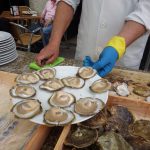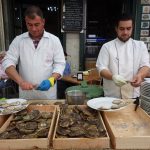 There’s an old saying that you shouldn’t eat oysters in months that don’t have an “R” in them? That would be May, June, July and August.
There’s an old saying that you shouldn’t eat oysters in months that don’t have an “R” in them? That would be May, June, July and August.
The idea behind this may have originally been sound. These months are summer months when coastal waters where shellfish are harvested are warmer and the risk for bacterial growth might be higher.
The concern behind this warning is Vibrio. This bacterium is a natural inhabitant of unpolluted coastal marine waters that is more prevalent in warmer water. People can get sick from this bacteria and the resulting illness is called vibriosis. The Center for Disease Control (CDC) https://www.cdc.gov/vibrio/index.html estimates that vibriosis causes 80,000 illnesses with 500 hospitalizations and 100 deaths a year. About 52,000 of these illnesses are estimated to be the result of eating contaminated food and the rest are caused by exposing open wounds to brackish or salt water containing the bacteria.
About 80% of Vibrio infections occur between May and October…oops…September and October has “Rs” in them….so there goes that myth.
The reason for the concern is that many people like eating raw or undercooked seafood and shellfish and this can make people sick. Thorough cooking of shellfish will kill these bacteria.
Healthy people exposed to Vibrio may experience nausea, stomach pain, abdominal cramps, vomiting and/or diarrhea. For most healthy people a mild case of vibriosis will recover in about 3 days.
Caution needs to be taken by those with chronic illnesses. At highest risk are those with diabetes, AIDS, cancer, cirrhosis of the liver, stomach or blood disorders. People with alcoholism and liver disease are at extremely high risk. These people should NOT eat raw shellfish. Cooked seafood and shellfish is safe for these at-risk people. 
Oysters seem to be the food most commonly linked to Vibrio. An oyster that contains harmful bacteria doesn’t look, smell or taste different from any other oyster. To protect yourself and family members:
- Oysters should be purchased from approved sources that are inspected and regulated. Oysters harvested from approved waters, packed under sanitary conditions and properly refrigerated are usually safe for raw consumption by healthy individuals
- If purchasing shellfish to serve raw make sure they are alive. Shells of live oysters will be tightly closed or slightly open. If the shell is gaping open or does not close after tapping it, the animal is dead and may harbor high number of bacteria. Discard any shellfish with open shells. After cooking, only eat shellfish that have opened during the cooking process.
- Don’t eat shellfish raw that has been shucked or removed from the shell and sold as “shucked” products. These previously shucked products are intended to be cooked before serving.
- Follow standard food safety precautions of washing hands before handling raw shellfish and avoid cross contamination with raw seafood and cooked foods.
- Properly cooking shellfish reduces the risk of illness. Oysters, clams, and mussels should be cooked in small batches so that those in the middle are cooked thoroughly. When steaming, cook for 4 to 9 minutes after the start of steaming. When boiling, after the shells open boil for another 3 to 5 minutes. Shucked products should be boiled for 3 minutes, or fried at 375°F for at least 3 minutes or baked at 450°F for 10 minutes. Shellfish should reach an internal temperature of 145 degrees F. They can also be cooked on a barbecue grill to the proper temperature.
You know how these “old sayings” go… so don’t believe the one about hot sauce or lemon juice either—they DO NOT kill the Vibrio bacteria. Neither does drinking alcohol while eating raw oysters.
If you’re an educator, the folks at Sea Grant http://www.safeoysters.org/ emphasize the importance of education and not frightening the consumers when teaching about seafood. Remember seafood can be a part of a healthy diet and is good source of low fat protein and Omega 3-faty acids with lots of positive health benefits. But we do need to remind consumers that eating raw shellfish can be risky and teach ways consumers can protect themselves and specifically those at the most risk.
Cheryle Jones Syracuse, MS
Professor Emeritus, The Ohio State University
It is time for holiday education
New Products Available Now
Check out the Nutrition Nuggets page which features over 20% off three special products each week.
Connect with us on Google Plus
















